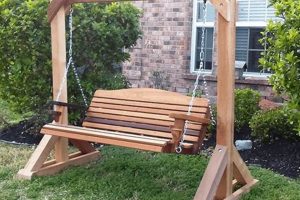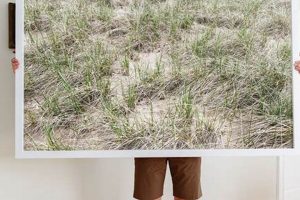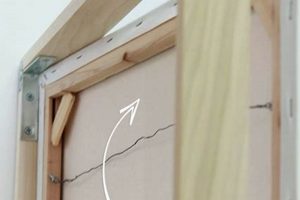A do-it-yourself project involving the creation of a display for photographs or artwork where the image appears to hover within a transparent border. This effect is typically achieved using two pieces of glass or acrylic, sandwiching the image, and then securing them within a frame that leaves the edges visible. For example, a user might construct this type of frame to showcase a particularly cherished print, highlighting its delicate edges and creating a minimalist aesthetic.
The appeal of constructing this type of display lies in its capacity to enhance visual interest and create a modern presentation. Its minimalist design directs focus solely to the art or photograph displayed. Historically, traditional frames often competed for attention, but this approach offers a clean, unobtrusive method for showcasing visual content. Further, the process provides a cost-effective alternative to purchasing pre-made versions and allows customization to specific dimensions and aesthetics.
The subsequent sections will outline the tools and materials required for this crafting process, detailed step-by-step instructions for assembly, and suggestions for personalization to suit individual style and space requirements. Considerations for image selection and optimal placement will also be addressed.
Construction Tips
The following are recommendations to ensure a successful outcome when engaging in the creation of a visual display, specifically one where the image appears suspended within a transparent border. Adherence to these guidelines will contribute to both the aesthetic quality and structural integrity of the finished piece.
Tip 1: Glass Selection: Utilize high-quality, low-iron glass or acrylic. This ensures optimal clarity and minimizes color distortion of the artwork being displayed. Standard window glass can exhibit a slight green tint, which may subtly alter the perceived colors of the enclosed image.
Tip 2: Precise Cutting: Accurate measurement and cutting of the glass or acrylic is critical. Inconsistent dimensions will result in a visibly uneven border and compromise the floating effect. Professional glass cutting services are recommended for those lacking experience.
Tip 3: Edge Finishing: Polished edges are essential, both for safety and aesthetics. Sharp edges pose a risk of cuts during handling and detract from the overall visual appeal. Edge polishing can be achieved with specialized tools or by contracting a professional glass finisher.
Tip 4: Image Preparation: Ensure the image is completely free of dust, fingerprints, or any other contaminants before being sealed within the frame. The transparent nature of the display will amplify any imperfections on the image surface.
Tip 5: Secure Mounting: The hardware used to secure the frame to the wall must be appropriate for the weight of the assembled display and the wall material. Insufficiently rated hardware can lead to the frame detaching from the wall, potentially causing damage or injury.
Tip 6: Consider Spacing: When selecting the frame material, factor in the thickness of the glass or acrylic. A frame that is too narrow will not adequately secure the glass, while a frame that is too wide will diminish the floating effect.
Tip 7: Sealing Considerations: If choosing to seal the perimeter, use a clear, non-acidic sealant specifically designed for glass or acrylic. Acidic sealants can damage the image over time. Apply the sealant sparingly to avoid visible excess.
Implementing these suggestions will contribute to a polished and durable result, enhancing the impact of the displayed image and prolonging the lifespan of the constructed piece.
The subsequent section will address common challenges encountered during the construction process and provide troubleshooting advice.
1. Material Selection
Material selection is a paramount factor influencing the final quality and aesthetic of a do-it-yourself visual display featuring a suspended image. The choice of materials directly impacts image clarity, structural integrity, and the overall visual appeal of the framed piece. Substandard materials can detract from the artwork or photograph, compromise the longevity of the frame, or even pose safety risks. For example, using low-quality glass can introduce distortions or a green tint, altering the perceived colors of the displayed image. Similarly, using a weak or brittle frame material can lead to structural failure over time, particularly with larger or heavier pieces.
Considering the transparent nature of these displays, the quality of the glazing material is particularly crucial. Options typically include glass or acrylic. High-quality, low-iron glass offers superior clarity and minimizes color distortion, but is more prone to breakage. Acrylic, while lighter and more impact-resistant, can be more susceptible to scratches and may not offer the same level of optical clarity. The frame material itselfwood, metal, or compositeshould be chosen based on aesthetic preferences, desired durability, and the weight of the enclosed image and glazing. A poorly chosen frame can buckle or warp under the weight, negating the floating effect. For instance, a user attempting to frame a large photograph might select a lightweight wood, only to find it bowing under the weight of the glass.
In summary, appropriate material selection is fundamental to the success of a visual display where the image appears suspended. It affects not only the visual presentation of the artwork but also the frame’s durability and longevity. Careful consideration of the specific properties of each material, weighing factors such as clarity, strength, weight, and cost, is essential for achieving a high-quality, long-lasting result that enhances the impact of the displayed image and adheres to safety considerations. A lack of foresight in this area will lead to undesirable aesthetic and structural outcomes.
2. Precise Dimensions
The accurate measurement and execution of dimensions are not merely important but fundamentally critical to the successful realization of a do-it-yourself visual display designed to create the illusion of a suspended image. Deviations from the specified measurements, even seemingly minor ones, can significantly compromise both the aesthetic impact and structural integrity of the finished piece. Attention to dimensional precision is thus paramount throughout the construction process.
- Glazing Size Concordance
The dimensions of the glass or acrylic panels must be precisely matched to ensure a flush and even surface. Any discrepancy will result in visible overlaps or gaps, detracting from the seamless appearance necessary for the floating effect. For example, if one panel is even a fraction of an inch larger than the other, it will create an unsightly ridge and disrupt the visual illusion.
- Image Centering and Border Uniformity
The internal dimensions of the frame and the size of the image must be carefully considered to achieve uniform border spacing. Inconsistent borders will create a sense of imbalance and undermine the overall aesthetic. If the image is not precisely centered within the frame, the uneven border distribution will immediately draw the eye and detract from the artwork itself.
- Frame Depth and Material Accommodation
The depth of the frame must be accurately calculated to accommodate the combined thickness of the glass/acrylic panels and the image. If the frame is too shallow, the panels will not be securely held, potentially leading to them shifting or falling out. Conversely, if the frame is too deep, it will create an unnecessarily bulky appearance and diminish the floating effect. Proper measurement ensures the frame provides adequate support without obscuring the transparent edges.
- Hanging Hardware Placement
Precise measurement is crucial for the accurate placement of hanging hardware. If the hardware is not positioned symmetrically, the frame will hang unevenly, distorting the perceived orientation of the image. Incorrectly placed hardware can also put undue stress on certain points of the frame, potentially leading to warping or breakage over time. Accurate measurements are necessary to ensure the frame hangs straight and securely.
The aforementioned dimensional considerations are indispensable for a successful project. These are critical to achieving both the aesthetic effect of a suspended image and the functional stability of the finished display. Any deviation from precise measurements can compromise both the visual appeal and the structural soundness of the frame, highlighting the importance of meticulous attention to detail throughout the construction process.
3. Secure Assembly
The concept of “secure assembly” directly correlates to the successful creation of a “diy floating picture frame”. It dictates the longevity, stability, and ultimately, the visual appeal of the finished product. Inadequate or improperly executed assembly techniques will undermine the intended aesthetic and potentially lead to structural failure. The cause-and-effect relationship is evident: subpar assembly results in a compromised frame, while meticulous construction ensures a durable and visually pleasing display. For example, failure to properly adhere the glass panels to the frame can lead to slippage, misalignment, or even complete detachment, negating the floating effect and potentially damaging the artwork. Secure assembly, therefore, is not merely a step in the process but a foundational element upon which the success of the entire project hinges.
The importance of secure assembly extends beyond mere structural integrity. It directly impacts the perceived quality and value of the display. A frame that exhibits visible gaps, uneven seams, or insecure fixings will appear amateurish and detract from the artwork it is intended to showcase. Conversely, a meticulously assembled frame, with clean lines and secure joints, conveys a sense of craftsmanship and attention to detail, enhancing the overall presentation. Consider the practical application of this understanding: a photographer showcasing their work at a gallery using poorly assembled frames risks diminishing the impact of their art due to the substandard presentation. Similarly, in a domestic setting, a well-constructed frame serves not only as a display but as a subtle testament to the homeowner’s taste and appreciation for quality.
In summary, secure assembly is an indispensable component of a successful “diy floating picture frame” project. It is the linchpin that connects aesthetic vision with practical reality. Challenges such as selecting appropriate adhesives, ensuring precise alignment, and achieving sufficient clamping pressure during assembly can be mitigated through careful planning and execution. The practical significance of understanding and prioritizing secure assembly lies in its ability to transform a potentially flawed project into a lasting and visually compelling display. Its importance extends to the broader theme of craftsmanship and the value of attention to detail in achieving a desired outcome.
4. Image Preparation
Image preparation is a critical phase in the construction of a visual display where the image appears suspended within a transparent border. This stage directly impacts the final presentation, as imperfections or contaminants present on the image will be magnified by the clear surfaces encasing it. Careful attention to detail during image preparation is therefore essential for achieving a professional and visually appealing result.
- Surface Cleanliness
The removal of dust, fingerprints, and any other surface contaminants is paramount. The transparency of the glass or acrylic panels used in this framing style accentuates any imperfections present on the image surface. Compressed air, a lint-free cloth, or specialized photographic cleaning solutions should be used to ensure a pristine surface. For example, the presence of even a small fingerprint can become a distracting focal point once the frame is assembled, undermining the overall presentation.
- Image Alignment and Trimming
Precise alignment and trimming of the image are necessary for achieving a balanced and visually pleasing composition within the frame. Misalignment or uneven trimming will result in asymmetrical borders, detracting from the floating effect. A cutting mat, ruler, and sharp blade should be used to ensure accurate and clean cuts. An example includes an image slightly skewed, causing an unbalanced and unprofessional look.
- Protection Against Fading
Considerations regarding image preservation should be addressed during preparation. Ultraviolet (UV) light can cause fading and degradation of the image over time. The use of UV-protective sprays or inks can mitigate this risk. Archival-quality prints are also recommended. Neglecting this aspect can result in the gradual deterioration of the image’s color and clarity, diminishing its visual impact. For instance, printing an image on non-archival paper, then leaving it in direct sunlight.
- Adhesive Application (if applicable)
In some construction methods, a light adhesive is used to secure the image between the glass or acrylic panels. The application of this adhesive must be uniform and minimal to avoid visible residue or distortion. Acid-free adhesives designed for archival use are recommended to prevent damage to the image over time. An uneven adhesive layer could lead to bubbles or wrinkles appearing between the image and the glass.
The steps involved in image preparation directly contribute to the quality of the finished display. A lack of attention to these details can negate the benefits of careful frame construction, resulting in a visually unappealing and potentially short-lived piece. The goal is to ensure the image is presented in its best possible light, free from imperfections and protected against degradation.
5. Hanging Method
The selection and implementation of a suitable hanging method represent a critical determinant in the overall success and visual presentation of a self-assembled visual display designed to emulate a floating image. The hanging method is not merely an afterthought but an integral component that directly influences the stability, security, and aesthetic integration of the display within its intended environment. The cause-and-effect relationship is direct: a poorly chosen or inadequately executed hanging method can lead to instability, damage, or a visually incongruous presentation, thereby undermining the intended effect. The significance of this component cannot be overstated; it is the point of interface between the artwork and its surroundings.
Practical considerations dictate the optimal hanging method. The weight and dimensions of the display necessitate appropriate hardware capable of providing secure support. Wire systems, D-rings, and specialized picture hanging hooks represent common choices, each with its own load-bearing capacity and aesthetic implications. The wall material further constrains the selection, requiring anchors or fasteners suited to drywall, plaster, or masonry. Incorrect hardware selection can lead to the display detaching from the wall, causing damage to the artwork and potentially posing a safety hazard. For example, employing a lightweight hook on a heavy glass-encased photograph risks failure. The method also impacts visual integration; a visible and obtrusive hanging system can detract from the minimalist aesthetic that characterizes this display style, while a discreet and well-integrated system enhances the illusion of suspension.
In summary, the hanging method is a key element that connects the physical attributes of the display with the desired aesthetic outcome. The challenges of selecting the appropriate hardware, accounting for wall material, and achieving visual harmony can be addressed through careful planning and attention to detail. The significance of understanding this relationship lies in its ability to transform a potentially flawed presentation into a secure and visually compelling display that enhances the impact of the artwork and seamlessly integrates into its environment. The hanging method must be considered holistically as part of the initial construction plan.
Frequently Asked Questions
The following addresses common inquiries regarding the construction of displays where images appear to float within a frame.
Question 1: What type of adhesive is best suited for securing the image within the frame?
An acid-free, archival-quality adhesive is recommended to prevent degradation of the image over time. Photo corners or double-sided archival tape are also suitable alternatives, as they minimize direct contact between the adhesive and the image surface.
Question 2: Is it necessary to seal the edges of the glass or acrylic panels?
Sealing the edges can protect the image from dust and moisture ingress. If sealing is desired, a clear, non-yellowing silicone sealant designed for glass or acrylic should be used. However, proper alignment and secure clamping during assembly may negate the need for sealing.
Question 3: What thickness of glass or acrylic is recommended for this type of frame?
A thickness of 2mm to 3mm is generally suitable for smaller frames. For larger frames, a greater thickness (e.g., 4mm or 5mm) may be necessary to prevent bowing or flexing of the panels.
Question 4: How can air bubbles be prevented when assembling the frame?
Ensure the image and glass/acrylic surfaces are completely clean and dry before assembly. Apply gentle, even pressure from the center outwards to avoid trapping air. Working in a clean, dust-free environment can also minimize the risk of air bubbles.
Question 5: What are the considerations for displaying this type of frame in direct sunlight?
Prolonged exposure to direct sunlight can cause fading and degradation of the image. The use of UV-protective glass or acrylic is recommended. Alternatively, consider displaying the frame in a location away from direct sunlight.
Question 6: How should the frame be cleaned without damaging the image?
Use a soft, lint-free cloth dampened with a mild glass cleaner or water. Avoid abrasive cleaners or excessive pressure, as these can scratch the glass or acrylic surface. Ensure the cloth is clean to prevent the transfer of dirt or oils to the image.
Proper material selection, careful assembly, and appropriate environmental considerations are key to preserving the display.
The following section will offer guidance on troubleshooting common issues encountered during construction.
Conclusion
The preceding information has outlined the critical aspects of constructing a do-it-yourself display characterized by an image suspended within a transparent frame. The success of this endeavor hinges upon meticulous material selection, precise dimensional execution, secure assembly methodologies, thorough image preparation, and a thoughtfully chosen hanging method. A deficiency in any of these areas can compromise the aesthetic and structural integrity of the finished piece.
The creation of a “diy floating picture frame” represents a synthesis of artistic vision and practical skill. The application of the principles detailed herein will empower individuals to craft a visually compelling and enduring showcase for treasured images. Continued refinement of technique and an unwavering commitment to quality will yield increasingly sophisticated and impactful displays.







